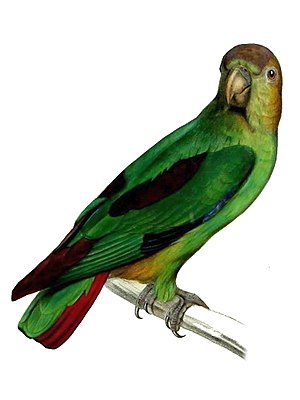Purple-tailed parrot
This article has been registered in the quality assurance biology for improvement due to formal or content-related deficiencies . This is done in order to bring the quality of the biology articles to an acceptable level. Please help improve this article! Articles that are not significantly improved can be deleted if necessary.
Read the more detailed information in the minimum requirements for biology articles .
| Purple-tailed parrot | ||||||||||
|---|---|---|---|---|---|---|---|---|---|---|

Purple- tailed Parrot ( Touit purpuratus ) |
||||||||||
| Systematics | ||||||||||
|
||||||||||
| Scientific name | ||||||||||
| Touit purpuratus | ||||||||||
| ( JF Gmelin , 1788) |
The Purple Parrot tail ( Touit purpuratus , Syn. : Touit purpurata ) is only a 17-centimeter bird art from the family of authentics parrots.
features
The birds have predominantly green plumage. The lateral feathers of the straight tail are purple-red with black tips in the males and green in the females. The dark brown shoulder and umbrella feathers form a V-shaped band when the wings are put on, the coverts under the wings are green. The two subspecies differ in the color of the skull and the back of the head ( occiput ): in the nominate form these are olive-brown, in Touit purpuratus viridiceps green. It is the only blue-tailed parrot with a blue rump .
The beak is light gray and the feet are black in color.
distribution
The purple-tailed parrot inhabits the forest savannah and forest edges from southern Colombia to the Amazon . It occurs up to an altitude of 1,200 meters.
Way of life
In small groups, these sociable birds roam the treetops in search of food and water. They feed on seeds, fruits, e.g. B. Mangoes , and young plant shoots. They are also common on plantations.
Reproduction
The birds use natural tree hollows or nests of tree termites as nests, into which the birds chop holes with their powerful beak. The female lays three to five eggs in it, which it then incubates for 25 days. After hatching, both parents take care of the young, which will fledge after eight weeks.
Subspecies
Two subspecies are distinguished based on their plumage color:
- Touit purpuratus purpuratus ( JF Gmelin , 1788) - The nominate form occurs from southern Venezuela via Guinea to northern Brazil .
- Touit purpuratus viridiceps Chapman , 1929 - This subspecies is present from the southeast of Colombia through the south of Venezuela to the northwest of Brazil. They can also be found in eastern Ecuador and northeastern Peru
Hazards and protective measures
Although no exact population numbers of this species are available, the IUCN classifies this species as Least Concern due to its wide distribution .
swell
- Jiří Felix (ed.), Alena Čepická: America's fauna in color. Translated from the Czech by Jaroslav Konšal. Karl Müller Verlag, Erlangen 1989., OCLC 247676131 , p. 123.
- Joseph Michael Forshaw (ed.), David Kirshner: Encyclopedia of the Wildlife: Birds. Translated from the English by Derek Vinyard. Orbis, Hamburg 2003, ISBN 978-3-572-01378-4 , p. 119.
Individual evidence
- ↑ Thomas Scott Schulenberg , Douglas Forrester Stotz , Daniel Franklin Lane, John Patton O'Neill , Theodore Albert Parker III : Birds of Peru . Princeton University Press, Princeton, New Jersey 2007, ISBN 978-0-7136-8673-9 , pp. 176 (English).
- ^ A b Joseph M. Forshaw : Parrots of the World. Christopher Helm, 2010, ISBN 978-0-691-14285-2 , p. 252.
- ^ IOC World Bird List Parrots ( Memento from August 6, 2012 in the Internet Archive )
Web links
- Touit purpuratus inthe IUCN 2012 Red List of Threatened Species . 2. Listed by: BirdLife International, 2012. Retrieved June 10, 2013.
- BirdLife International: Species Factsheet - Sapphire-rumped Parrotlet ( Touit purpuratus ) . Retrieved June 19, 2012.
- Videos, photos and sound recordings of Sapphire-rumped Parrotlet (Touit purpurata) in the Internet Bird Collection
- Purple- tailed parrot ( Touit purpuratus ) at Avibase; Retrieved June 19, 2012.
- Touit purpuratus in the Integrated Taxonomic Information System (ITIS). Retrieved June 19, 2012.
- xeno-canto: Sound recordings - Sapphire-rumped Parrotlet ( Touit purpuratus )